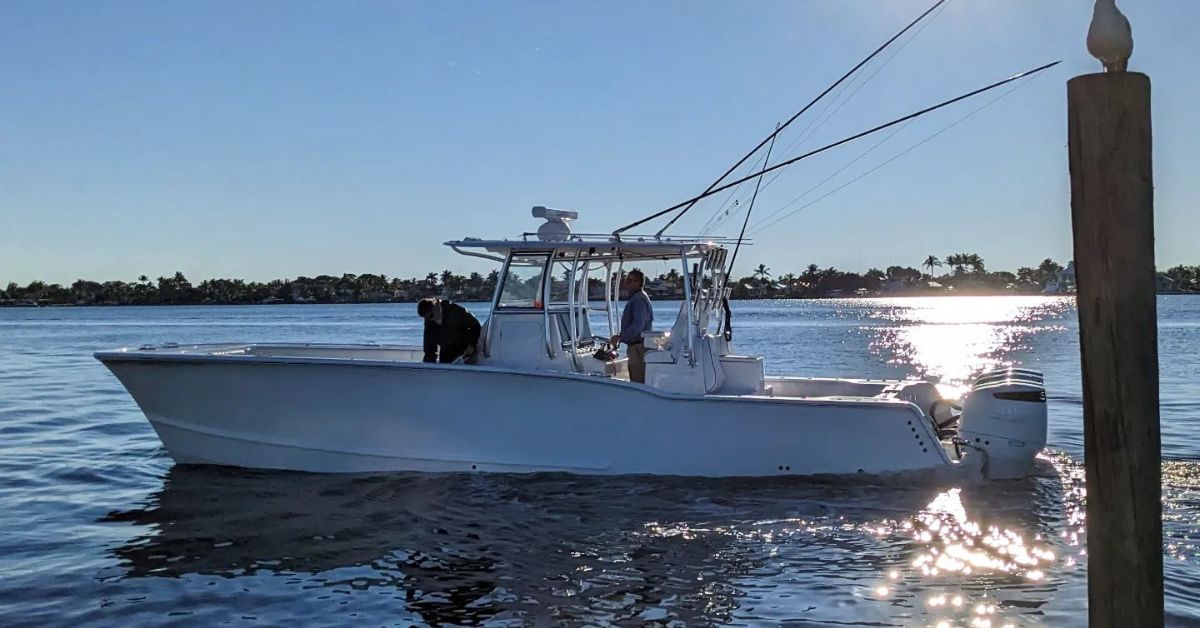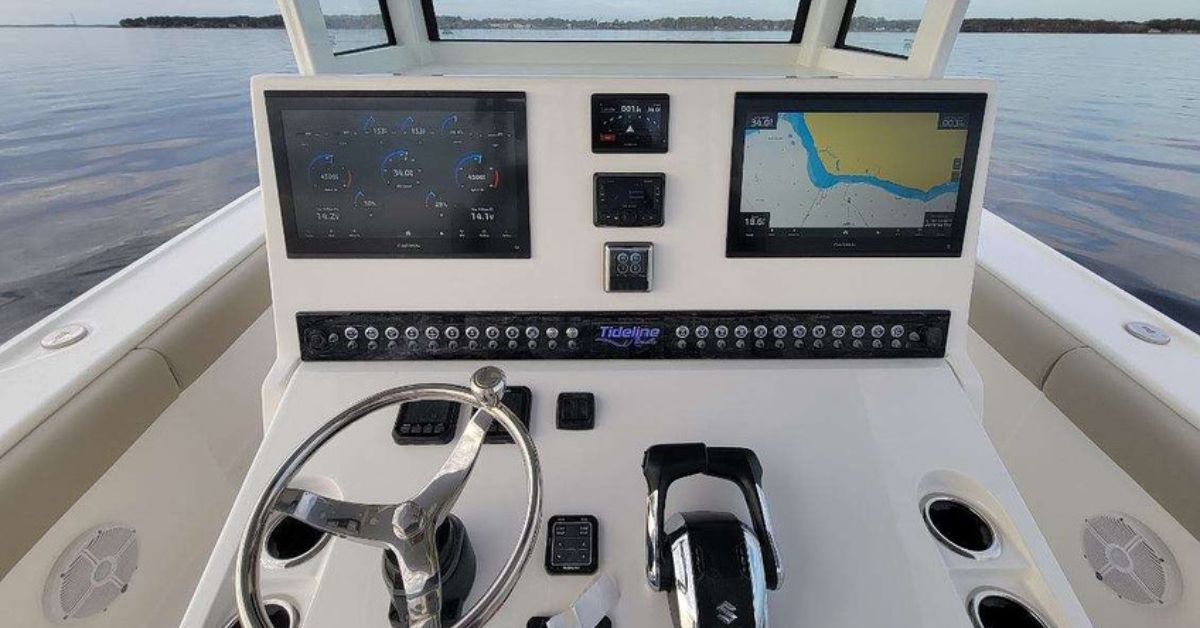Your boat’s electronic systems serve as your digital crew, so choosing the right chartplotter and fishfinder can make or break your time on the water. Two brands consistently dominate conversations among serious boaters: Garmin and Simrad.
Both companies have earned their reputations through decades of innovation and reliability. Garmin brings its consumer electronics expertise to the marine world, while Simrad focuses exclusively on professional-grade marine solutions.
Each brand offers compelling advantages, but determining whether Garmin vs. Simrad marine electronics is best for you depends entirely on your specific boating needs, experience level, and budget. This comprehensive comparison will help you understand the strengths and limitations of both brands, enabling you to make an informed decision for your vessel’s electronic upgrade.
Garmin Marine Electronics Overview
Garmin entered the marine electronics market with the same user-friendly approach that made their GPS devices household names. Their marine product lineup spans from basic chartplotters for weekend anglers to sophisticated multifunction displays for serious offshore enthusiasts.
The company creates intuitive interfaces that don’t require extensive technical knowledge. Garmin’s GPSMAP series offers touchscreen navigation with smartphone-like responsiveness, while its ECHOMAP series combines sonar and mapping capabilities in affordable packages. Their newer Panoptix sonar technology provides real-time underwater imaging that transforms how anglers locate and track fish.
Simrad Marine Electronics Overview
Simrad approaches marine electronics from a commercial fishing and professional maritime perspective. Founded in Norway, the company has deep roots in harsh marine environments where equipment failure isn’t just inconvenient, it’s dangerous. This heritage shows in their robust construction and advanced feature sets.
Simrad’s NSS evo3 and NSO evo3 series are their flagship offerings, featuring high-resolution displays and processing power that handles complex navigation tasks effortlessly. Their ForwardScan sonar technology excels in shallow water navigation, while their Halo radar systems provide exceptional target separation and weather tracking capabilities. Professional captains and serious offshore boaters often gravitate toward Simrad for its reliability and advanced functionality.

Key Features Comparison
Chartplotters
When comparing chartplotters, both brands offer excellent mapping capabilities, but their approaches differ significantly. Garmin’s BlueChart g3 Vision maps include detailed coastal imagery and auto-guidance technology that suggests safe routes. Their interface emphasizes simplicity, with large icons and intuitive menu structures that new users can master quickly.
Simrad chartplotters feature C-MAP charts with high-resolution bathymetric data that is invaluable for serious fishing applications. Their displays typically offer more customization options and can handle multiple data sources simultaneously without performance degradation. The learning curve is steeper, but experienced users appreciate the granular control over every system parameter.
Fishfinders
Fishfinding capabilities showcase each brand’s philosophy clearly. Garmin’s ClearVü and SideVü sonar create photo-like images that immediately make sense to casual anglers. Their LiveScope technology provides real-time sonar that lets you watch fish react to your lure, revolutionizing ice fishing and shallow water angling.
Simrad’s sonar solutions emphasize professional-grade performance with their StructureScan and SpotlightScan technologies. These systems excel in deep water applications where target separation and interference rejection become critical. Commercial fishermen and tournament anglers often prefer Simrad’s sonar for its precision and reliability under challenging conditions.
User Experience
Garmin prioritizes accessibility in its user interface design. Their marine units feel familiar to anyone who has used a smartphone or tablet, with pinch-to-zoom functionality and logical menu hierarchies. Software updates arrive regularly, often adding new features to existing hardware. Customer support operates through multiple channels, including phone, email, and comprehensive online resources.
Simrad interfaces cater to users who want maximum control over their systems. Multiple screens can display different information simultaneously, and experienced operators can customize layouts extensively. While this flexibility empowers advanced users, newcomers may feel overwhelmed by the options available. Simrad’s customer support tends to be more technical in nature, reflecting their professional user base.
Integration Capabilities
Both brands support NMEA 2000 networking standards, allowing integration with third-party equipment like engines, autopilots, and weather stations. Garmin’s ecosystem approach encourages users to stay within their product family, offering seamless compatibility between their marine electronics, watches, and mobile apps.
Simrad takes a more open approach, offering extensive compatibility across various manufacturers’ equipment. Their systems often serve as central hubs in complex installations featuring multiple radar units, communication systems, and vessel monitoring equipment. This flexibility makes Simrad popular for custom installations on larger vessels.
Price Comparison
Entry-level Garmin units typically cost less than comparable Simrad models. A basic Garmin ECHOMAP chartplotter starts around $200–400, while entry-level Simrad units begin around $800–1200. However, pricing becomes more competitive as you move up to premium models with similar feature sets.
High-end systems from both manufacturers can exceed $10,000 for complete installations. Simrad’s professional focus often translates to higher prices, but you’re paying for construction quality and features designed for commercial applications. Garmin offers better value for recreational users who don’t need commercial-grade durability.

Pros and Cons Analysis
Garmin excels at making sophisticated technology accessible to everyday boaters. Their units work well right out of the box, with minimal setup required. Regular software updates keep older hardware current, and their ecosystem approach means devices work together seamlessly. However, Garmin offers less flexibility for custom installations and fewer advanced features than similarly priced Simrad units.
Simrad delivers professional-grade performance with extensive customization options. Their displays remain readable in bright sunlight, and processing power handles multiple demanding applications simultaneously. Construction quality typically exceeds Garmin’s consumer-focused approach. However, the learning curve is steeper, and prices generally run higher for equivalent screen sizes and basic functionality.
Making the Right Choice for Your Vessel
When deciding whether Garmin vs. Simrad marine electronics is best for you, you should reflect on your boating style, experience level, and long-term plans. Recreational boaters who prioritize ease of use and value will find Garmin’s offerings compelling. Weekend warriors, casual fishermen, and new boat owners benefit from Garmin’s intuitive interfaces and comprehensive support resources.
Serious offshore fishermen, professional captains, and boaters who demand maximum performance should consider Simrad seriously. The initial learning curve pays dividends in functionality and reliability when conditions become challenging.
At Tideline Boats, we understand that every angler has unique electronic preferences. That’s why we build our high-performance coastal boats to accommodate either Garmin or Simrad systems seamlessly. Our custom installation approach ensures your chosen electronics integrate perfectly with your vessel’s design, whether you prefer Garmin’s user-friendly approach or Simrad’s professional capabilities. Contact us to discuss how we can customize your next boat with the marine electronics that match your fishing style and technical preferences.


